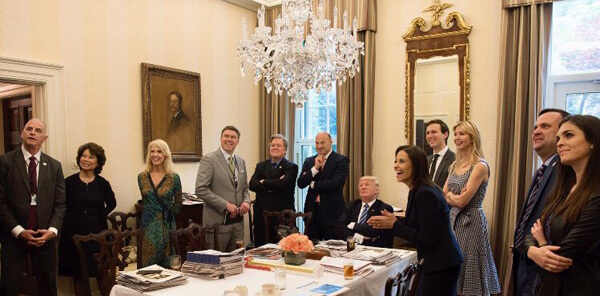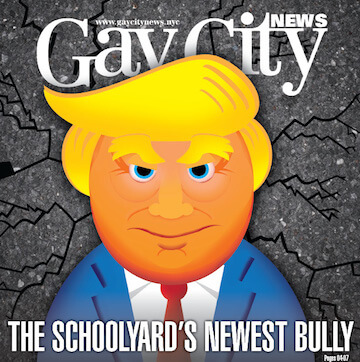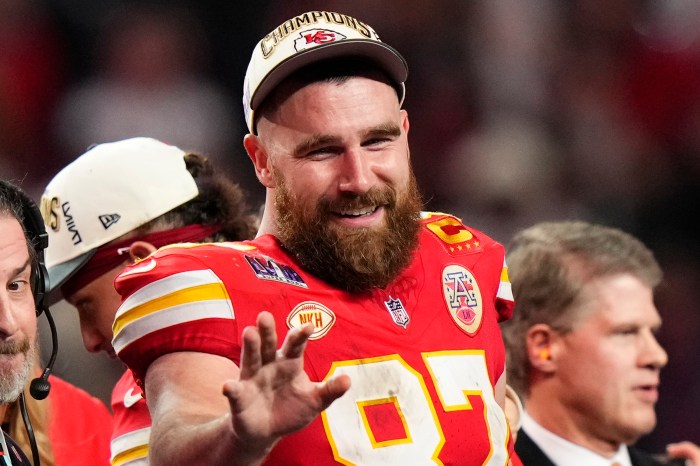g lounge was a fixture in Chelsea for nearly 20 years, until New Years Eve. | GLOUNGE.COM
BY ED SIKOV | A spate of articles has appeared lately on the subject of gay bars shutting down, and strangely, they all conclude that it’s A Good Thing. In the last two weeks, the Chicago Tribune, The Economist, and the website The Good Men Project have all published articles that examine the trend, which expressed itself locally on New Year’s Eve when g lounge, the popular gay hangout on West 19th Street in Chelsea, held its closing night bash. So what killed g lounge, and why – as the Trib piece asks in its headline – “From Indianapolis to London: Are gay bars going extinct?”
“Since 2015 at least five have closed their doors in Indianapolis, about half the city’s total,” the Trib writes. “Among the casualties: the venerable Varsity, the city’s oldest gay bar, dating back to the 1940s. In the past six months Talbott Street, long-known for its drag shows, closed, as did the 501 Eagle, a bar favored by leather enthusiasts since 1986.”
What shocks me most about this is the revelation that until very recently Indianapolis sported 10 gay bars. Indianapolis! This goes a long way toward explaining Indiana Governor and soon-to-be-Vice President Mike Pence’s pronounced homophobia – his state’s capital featured a gay bar on practically every block! He couldn’t take a step outside the capitol without being forced to see gay people drinking, laughing, and enjoying the company of other gay people. It obviously drove him berserk.
MEDIA CIRCUS
The Trib quotes a bartender who offers one theory of gay bars’ demise: “Jack LaFary poured the last of the drinks at the 501 in October but had seen the end coming well before then. ‘Guys my age stopped going out to bars all the time,’ said LaFary, 48, ‘and the new generation never did catch on.’” One wonders if LaFary is the name he was born with.
“It’s the same elsewhere,” the Trib continues. “The 501’s closing ‘comes just weeks after the Barracks closed in Louisville,’ reported the gay news website Great Lakes Den, lamenting that ‘most of Indiana will no longer have easy access to a leather bar.’ San Francisco was down to just a few dozen gay bars compared with more than 100 in the 1970s, according to a 2011 report in Slate, and Manhattan had but 44, half as many as it did at its gay-bar peak in 1978. In London the Queen’s Head, a gay bar since the 1920s, closed in September, going the way of other prominent gay bars in that European capital.”
It takes a few paragraphs to get there, but the Trib finally gets to the fundamental reason that gay bars are disappearing: “‘It all changed with smartphones,’ LaFary said, referring to the widely held theory that mobile dating apps like Grindr, by facilitating meetups online, helped render bars unnecessary. ‘When I first came out, you went to a gay bar to meet gay people. But the smartphone changed that, and it was an all-of-a-sudden thing. Business just dropped, and it wasn’t a gradual thing. It was, like, boom.’”
In times past, if you wanted to get laid you had to spend money on drinks and a coat check – money that might have been better spent on rent. You also had to exhibit yourself – in person – to a crowd of sex-hungry men or women who immediately compared (or as I experienced it, contrasted) you to the seemingly perfect specimen who commanded the bar patrons’ full attention in his (or her) skin-tight tank top, which you knew (usually) he’d lose before you finished your first $5 drink, thereby rendering you irrelevant and invisible. How 20th century! No wonder the so-called “dating” apps like Grindr changed the whole nature of gay hookups. Now you not only avoid the expense of drinks and coat checks but you can turn yourself into a sex god with the simple aid of a computer. With an initial investment of time – to find your (or your dick’s) best angle, you can take a bunch of shots, you can manipulate the lighting, crop out your sagging belly, and come out looking like the freshest piece of meat at the butcher’s counter. You may still get rejected, but – and this is the key to the whole thing – you’re not there to witness the rejection! It happens in some other guy’s apartment without you being aware of having even being swiped. That’s the real beauty of Grindr.
Ah, but my misanthropic negativity is showing. Gay and lesbian bars were places of camaraderie! The good times rolled! The Economist is particularly nostalgic: “In America these bars popped up more and more after the Second World War, during which millions of people, many of whom were from small towns or suburbs, were posted in big cities such as New York and San Francisco. When the war ended many gay people wanted to stay together. This is partly how homosexual districts, such as the Castro in San Francisco and Greenwich Village in New York, developed. In these neighbourhoods gays and lesbians had their own restaurants, book shops, church groups, and newspapers.”
The Economist continues: “Along with being places to hook up, the bars in these districts also let gay people try on new identities, says Jim Downs, a historian at Connecticut College who has written about the gay-liberation movement. Some men went to bars dressed as police officers or leather-clad motor bikers. Others preferred the ‘ballroom scene,’ in which they wore extravagant dresses and competed to throw the wittiest put-downs at each other. Lesbians could be ‘butch dykes’ or ‘femmes.’ Hairy, burly men called themselves ‘bears.’ Such subcultures still exist (‘for bears and their admirers,’ reads the slogan for XXL, a London nightclub).”
Always with an eye to money, the Economist cites another problem facing gay and lesbian bars: skyrocketing rent: “In the rich world it is no longer raids that threaten gay bars; the biggest problem facing most is rent. These places are often in scruffier parts of cities. As cities become wealthier, and as pressure on space intensifies, they are squeezed out. In Brooklyn the Starlite Lounge, which had been open since the 1950s, faced a rent rise in 2010. The managers were forced to close despite a campaign to save it. Today the building is occupied by a local deli, the owner of which also says that his rent has become too steep. In London the Candy Bar, a lesbian venue, closed in 2014 after two decades of serving drinks to women in a dark, rather dingy space when its landlord increased the rent. In an ironic twist, the bar is now a lap-dancing club.”
The Economist eventually gets around to Grindr: “Mobile-phone apps such as Grindr for men and Her for women have eliminated much of the need to lock eyes across a crowded room. Instead potential partners can be found while at home or in the lunch-break at work by ‘swiping’ to find people nearby. Some 2m men use Grindr globally [!]. The app allows them to see and talk to other men who are online nearby, to either forge relationships or have casual sex. Other apps allow people to search for people in other countries, suddenly making the gay bar global. ‘The efficiency is unparalleled,’ boasts Robyn Exton, the founder of Her, which has 1.5m users.”
So why is the collapse of gay bar culture A Good Thing in the eyes of the Economist? “Perhaps the biggest reason gay bars are disappearing is because of increased acceptance of homosexuality in the rich world. According to a study in September from Pew Research Center, an American think-tank, 87 percent of those asked knew someone who was gay or a lesbian. One in five American adults say their views on homosexuality have changed over the past five years (most have become more accepting). Similarly in Britain, views on homosexuality have become markedly more tolerant. This means that many gay men and women, particularly youngsters, do not feel the need to congregate in one spot. In big cities such as London or New York they can display affection in many bars and pubs, while they frequently live in areas of cities that are more diverse.”
So all is well! Gay bars are forced to close because their patrons are oh-so-accepted in and by the mainstream. Why surround yourself with your own community when you can spend your free time with a crowd of delightful straight folks? Why go to Julius’ when you can go to happy hour at T.G.I. Friday’s instead? Personally, I love cocktails near shrill parents and their noisy brats while tacky Lite-FM-style music plays on the sound system.
The Economist takes a peculiar view of how gay bars help ameliorate the stigma of being gay. It starts off well: “While these places close down in the rich world, they remain as important as ever in the developing world. In Kampala, the capital of Uganda, where homosexuality is illegal, a gay club night takes place at a particular restaurant every Sunday evening. ‘We dress up, cross dress, dance, dance, dance,’ says Frank Mugisha, a gay-rights activist. ‘But you wouldn’t know about it unless you knew someone who goes,’ he adds.” Then the skies darken: “These places are facing many of the problems that gay bars in New York or London experienced four decades ago. In August the Ugandan police stormed a gay and transgender fashion show, beating the participants and locking them up in jail for a night. Similarly in Yaoundé in Cameroon, where homosexuality is also illegal, police officers surrounded Mistral Bar in October, holding the patrons inside for some time before arresting all of them.”
Gee, this makes Grindr look benign. I’d take Grindr’s heartlessness over a stinking Yaoundé jail cell any day.

































